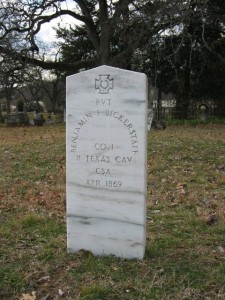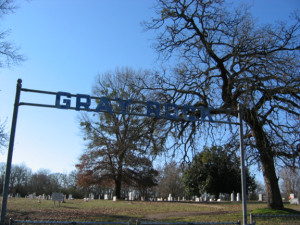
Confederate grave marker for Bickerstaff in Alvarado, Johnson County, Texas. The style is one used after 1900, indicating it was placed there after his death in 1869.
Benjamin F. Bickerstaff, like so many Confederates from Texas at the end of the Civil War, returned to the Lone Star State, with no intention of acknowledging defeat or becoming reconstructed. They created an environment of hate, destruction, and terror for all former slaves, Union supporters, Freedmen’s Bureau agents, and Union soldiers.
Early in March 1865 the Galveston Daily News reported that roving bands of guerillas infested Red River County and plundered the people of Clarksville. Later that summer the same newspaper commented on the rapid increase of crime, with accounts of robberies, murders, and wholesale arson throughout the Texas. Men of “all grades seem to have entered on the career of crime and doubtless find it profitable since they commit their deeds without impunity.” Civil law was dead; sheriffs and judges watched while murderers came and went at will.
Bickerstaff grew up in the community of Gray Rock in southwest Titus County, joined the 11th Texas Cavalry where he saw action at Elkhorn Tavern and Murfreesboro before taken prisoner and sent to Rock Island Federal Prisoner of War camp. Sometime in his career he was demoted from Forage Sergeant to Private for forcing white Unionists in east Tennessee to either stand in scalding water or held their feet to a fire to convince them to confess where they had hidden their valuables.
Somehow Bickerstaff managed to escape before the final exchange of POWs. By spring of 1865 he was riding with Cullen Montgomery Baker and Ben Griffith in Arkansas and the extreme northeastern counties of Texas. Local tales in Titus County indicate he killed at least one freedman in or near Shreveport before fleeing into Texas to avoid the arrival of the U. S. occupational forces. Bickerstaff, and Baker soon became allied with Bob Lee of the Corners Area where Hunt, Collin, Fannin, and Grayson Counties join. The three were dubbed the Unholy Triumvirate. Lesser-known cutthroats quickly joined them to control the vast area of North Texas from Texarkana and Jefferson to Fort Worth and Johnson County.
One of the first places occupied by Federal troops was Mount Pleasant in Titus County. At that time in 1867 Bickerstaff moved his gang over to the thickets of White Oak Creek just north of Sulphur Springs in Hopkins County. Throughout the area friends and allies along with those whom they intimidated fed the outlaws, warned them of danger, provided horses and forage while safeguarding them. The thickets provided an ideal hiding place where few ventured for fear of outlaws or becoming lost.
On August 10, 1868 Company H of the 6th U. S. Cavalry from Fort Richardson arrived in Sulphur Springs under the command of Captain T. M. Tolman. Four days later Tolman received a report of an African American woman beaten by Bickerstaff’s gang. A squad of seven men went to investigate. On return Bickerstaff’s men ambushed them, killing a Union sergeant and a private. Shortly after that General J. J. Reynolds of U. S. occupational forces place a $1,000 reward on the heads of Bob Lee, Ben Bickerstaff, and Cullen Montgomery Baker. The Unholy Triumvirate was doomed.
As the November presidential elections neared Bickerstaff and his men declared open warfare on the Union troops. Desperados surrounded the post with an estimated 200-500 men. Food, water, and wood were cut off after the two attempts were made to burn the town. Sulphur Springs was in a virtual state of siege. At the last minute two more companies arrived from Fort Richardson with orders to rid the area of Ben Bickerstaff and his men.

Cemetery at Gray Rock in southern Franklin County. Seborn and Frances Bickerstaff along with their son James, his family, and daughter Amanda and her family are buried there. Local legend states that Ben Bickerstaff is buried in an unmarked grave.
In late 1868 Bickerstaff moved his operations to Hill and Johnson Counties. There he joined forces with an old friend Josiah Thompson. Together they relieved a courier on his way to Austin of $2,800 in state tax money. They also confiscated his two Derringer pistols and a gold watch. As winter turned to spring Bickerstaff and Thompson regularly rode into the small town of Alvarado each evening to drink, carouse, and shoot up the town. By April the townspeople were fed up with the two outlaws but at their wits’ end how to stop the harassment. Finally the shop owners decided to arm themselves and ambush the desperados when they rode into town on Monday, April 5, 1869. Thompson and Bickerstaff dismounted to a fuselage of bullets. Thompson died immediately. As Bickerstaff lay dying in the streets of Alvarado, he told his assassins they had “killed one of the bravest men of the South.”
The next morning a group of Alvarado men set out to claim the reward after beheading the notorious Bickerstaff. His head was sent to the 5th Military Headquarters in Austin. But what happened to the body? Some say his widow hired a wagon to take his remains to Titus County where they were buried in an unmarked grave in Gray Rock Cemetery. Yet there is a Confederate grave marker in the old Alvarado Cemetery just off the public square where Bickerstaff met his match. Who knows? Or maybe, who cares?
Taken from The Devil’s Triangle: Ben Bickerstaff, Northeast Texas, and the War of Reconstruction in Texas by James M. Smallwood, Kenneth W. Howell, and Carol C. Taylor. For more information please contact East Texas Historical Association at 936-468-2407 or sosebeem@sfasu.edu.

Pingback: John Franklin Boyd (the elder) | Family Quest- Boyd and Dunham
Thank you for this!
I have ancestors from White Oak that I just discovered. I don’t know much about them except that they were married in Hopkins County in 1866. This gave me a really clear idea of their environment.